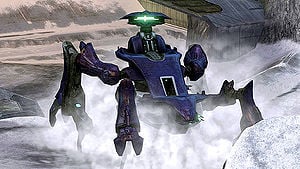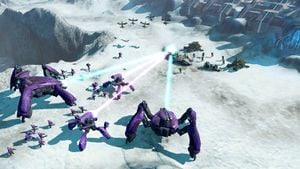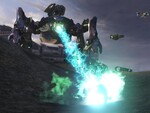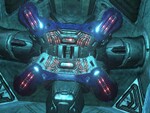Deutoros-pattern Scarab
From Halopedia, the Halo wiki
- "We've all run the simulations. They're tough, but they ain't invincible!"
- — Sergeant Major Avery Junior Johnson[1]
The Type-47 Ultra Heavy Assault Platform, more commonly known as the Scarab, is a Covenant mobile mining platform adapted for use in combat.[2]
Introduction
Developed in an advanced construction site, Scarabs are mobile fortresses. The quadrupedal behemoths are typically deployed from low- or medium orbit, or from high atmosphere. They are used to attack heavily-defended structures, and often lend quick but unstoppable support to Covenant troops on the ground.
Scarabs are extremely powerful, possessing an exceptionally powerful plasma beam (mounted onto its "head") as well as one or two dorsally-mounted anti-air cannons. Their "bodies" are massive and multi-level, and they possess four legs. Unlike most Covenant vehicles, Scarabs do not use anti-gravity propulsion to move. Scarabs instead walk using their massive legs, which are surprisingly swift and precise given their size. The legs can also be used to crush enemy forces on the ground. It is thought that some amount of anti-gravity propulsion is used to reduce stresses on the legs.
Despite their enormous strength, however, Scarabs are quite vulnerable to being boarded; a Scarab's central core is protected only by the vehicle's external armor, so attacking the core is easy once an enemy boards the craft. A Scarab will also be temporarily stalled if its legs sustain enough damage, allowing a would-be boarder to simply jump into the vehicle's troop bay. To counter this, Scarabs typically carry squads of Unggoy and Kig-Yar, as well as some Jiralhanae and Sangheili.
Scarabs have been used in many battles during the Human-Covenant War, including the Fall of Reach, the Battle of Earth and the Battle of Installation 00, usually to great effect.[3]
Variations
Halo 2 (Scarab V1)
The Scarab was first seen in Halo 2 level Outskirts, where it appeared as a large, four-legged, silver-armored behemoth with an estimated height of one hundred feet. It featured an upper deck that was guarded by numerous Sangheili, Kig-yar, and Unggoy, along with a walkway going over the entrance to the control room. This model is manned by a traditional crew, rather than being controlled by Lekgolo worms.
Scarabs' armor were invulnerable to damage from 90mm shells, 102mm shaped charges,.50 caliber rounds, and ANVIL HE missiles; the armor could be similar to the plating used on Covenant warships. In addition to the vehicle's main gun, two large anti-aircraft plasma weapons are mounted on top of the walkway; this weapon was used to neutralize the Pelicans ferrying John-117 and his strike team while en route to Regret's Assault Carrier.
The model featured in Halo 2 is often theorized to be a dedicated excavation platform (and was used as such in the game), in contrast to the more combat-ready model featured in Halo 3, Halo Wars, and Halo 3: ODST, as it lacks many of the onboard weapons featured on the other model. Its size makes it considerably less maneuverable than the smaller variant, preventing it from engaging fast-moving targets while confined in narrow areas, such as city streets. This handicap leaves it susceptible to boarding actions.
Halo 3, Halo 3: ODST, and Halo: Reach (Scarab V2)
Halo 3, Halo 3: ODST, and Halo: Reach feature the Scarab, which features a much different chassis. Unlike its Halo 2 predecessor, the V2 Scarab tank is now completely destructible. Its appearance has been completely altered, with a differently-shaped body and a more bulbous end. It seems to be shorter but wider, and it is purple rather than silver and blue. The legs appear to be more capable of sustaining a high impact. The V2 Scarabs are piloted by Lekgolo worms, whereas the original Scarabs were piloted by Covenant infantry.
In terms of weaponry, the V2's plasma beam is smaller and seemingly weaker; on Legendary, the Halo 3 beam takes almost a full second to kill a player, while in Halo 2, the beam is instantly fatal, and the beam also has a much lower velocity. The beam also looks more hose-like, whereas the beam in Halo 2 was a straight line. The two anti-air turrets on the Halo 2 Scarab have been replaced by a single, larger turret on the craft's rear. The flaps on the plasma beam are now small pads, and do not constitute the majority of the "head" as is the case in Halo 2.
As pointed out before, the Scarab now appears to have no crew controlling it, just guards, to keep boarders off, and it is controlled by Lekgolo worms.[4] Also while shooting exposed Lekgolo worms the worms will bleed, although the blood will not show on the ground. This has been proven in the December issue of Game Informer, in an article on the Mythic map pack. The level Assembly was shown to be a Scarab factory, and it was stated that tubes could be clearly seen on the level, injecting the worms into the Scarab shells.
Scarabs in Halo 3 are controlled by NPC AIs, unlike the Halo 2 Scarabs, whose paths were scripted. Halo 3 Scarabs also leak a green fluid from their main guns; this is most likely the same radioactive/incendiary fluid as that seen used in the Hunters' assault beams.
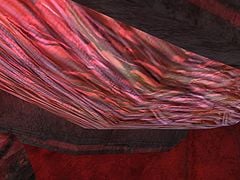
A likely conjecture is that this version of the Scarab was intended to be a weapon. Its color changed to a shade of purple, like other Covenant war-ready vehicles, and it was better-defended and more heavily armed. It has been speculated that Scarabs of Halo 2 were not weapons, but rather mining tools that were deployed as emergency combat relief by Regret upon finding humans on Earth. They could have been the mining Scarabs from Halo: The Fall of Reach. This is supported by the fact that the Prophet of Regret was looking for the Artifact that opened the portal to the Ark, and he needed digging machines to excavate it.
Differences aside, it still had many similarities to the old Scarab. There were three levels (or decks), and the lowest was accessible when the Scarab had been temporarily disabled. This level featured a rear-mounted plasma turret, and usually one to four Brutes, depending on the difficulty level. There was a ramp that led to the second level, where there were a varying number of enemies, depending on the level and difficulty. Usually, you could expect to find a few Brutes and Grunts. On this level, there were two more plasma turrets, aimed to either side of the Scarab. If you turned 180° immediately upon ascending the ramp to this level, you could go up the purple slope to the third tier. This was just an open, unprotected platform below the large turret. Past the turrets on the second level (round the corner) is the power core that must be destroyed to kill the Scarab.
The Scarab in Halo: Reach is of the V2 design, and appears several times in the campaign. However, during the Halo: Reach campaign although they appear in the playable environment, the player is instructed to not destroy them. If the player manages to board one, they will find that the Scarab cannot be destroyed. This, coupled with the relatively low texture quality of the scarab, is because the player is not meant to spend any amount of time near the scarab, instead racing past on mongoose. It's likely that the Halo: Reach model of the Scarab uses the same textures and models from Halo 3. It would explain why the core of the Scarab can still be destroyed but instead of destroying the scarab, it reveals a hole in the wall after it is destroyed.
Halo Wars
Scarab V2
The Scarabs in Halo Wars seem to be nearly identical to their Halo 3 counterparts, but smaller (likely due to gameplay reasons). These behemoths are very slow and expensive to build (3,000 resources and 20 population in Skirmish), with no upgrades available due to their cost.[4] Up to two can be spawned at a time in a Standard Skirmish and four in Deathmatch mode. The latest Title Update for Halo Wars enhanced the Scarab unit by providing an additional 25% hitpoints and produces increase damage of 25%, and is now capable of surviving four direct MAC blasts as a result of the improved hitpoints.
The Scarabs excel at attacking vehicles and infantry with their powerful weapons, though it has difficulty in taking down aircraft, and are very mobile, being able to climb over most obstacles. Only certain obstructions, like craters or fire, can block them. Like their Halo 3 counterparts, Halo Wars Scarabs are controlled by Lekgolo worms, but a Sangheili or Jiralhanae will respond to orders given to the Scarab. However it is likely that these Scarabs also have more conventional controls as in the campaign level Beachhead the player may use a Spartan to commandeer an abandoned Scarab. Commandeering this Scarab and using it to destroy 25 enemy units unlocks the achievement Beaming with Pride.
Scarabs are extremely difficult to destroy. Overwhelming it with a massive attack force works well, particularly when using anti-vehicle units like the Cobra and Hunter, but a significant portion of the attack force will be lost in the process. An upgraded MAC Blast or Carpet Bomb can destroy a Scarab rather quickly, as can a group of Vultures using their missile barrages. Covenant leader units' special abilities can inflict massive damage on a Scarab, with the Prophet of Regret's Cleansing Beam being a good example.
Winning a Skirmish game with two Scarabs unlocks the 2 Bugs Are Better Than 1 achievement.

Super Scarab
There is a large, incomplete Scarab in the seventh Campaign mission of Halo Wars. It is substantially larger and more heavily armored than a standard Scarab, and it appears to be completely mechanical. It has an extremely high amount of hit points, able to sustain fire from up to nine MAC rounds on the Easy difficulty, and it cannot be boarded. In addition to its incomplete state (and immobility), it projects a beam of light that shows where its attention is currently focused. To slow down the speed of its searchlight, the player must destroy seven power nodes. Given the design of the chassis, it is likely that this is an excavation Scarab, much like the ones in Halo 2. It should be noted that the abandoned Scarab in the level Beachhead is also referred to as Super Scarab, though it seems to be a normal Scarab in every regard but title.
Destructible Parts
Halo 2
The Halo 2 Scarab was almost indestructible and immune to damage in the game. Its movement was entirely scripted, and no damageable parts appear to have been coded for it. It was only destroyed in a cutscene. When the Halo 2-era Scarab fires, some molten, green liquid (possibly coolant or excess plasma) will leak out below the main cannon.
The forward plasma turret could be destroyed with just a few melee attacks, as could the rear plasma turret. The flaps on the main gun could be destroyed only by using a Scorpion tank. Also, the underside grate could be destroyed.
Halo 3 and Halo 3: ODST
Halo 3 Scarabs have far more destructible parts than their Halo 2 predecessors. Destructible armor covers each joint of a Scarab's legs, and doing enough damage to the legs will cause the Scarab to go into lockdown, making it stop moving altogether. The flaps covering the main gun can be destroyed, though this does not affect the gun's operation. The crest on and around the rear anti-air turret can be completely blown off, slowing the turret's rate of fire and reducing the size of its plasma bolts. Two side door panels near the bottom of the Scarab's rear can be torn off, allowing entry onto the vehicle.
A Scarab's rear armor possesses a glowing red circle; inflicting enough damage upon this circle will detach the armor, leaving the Scarab's core exposed. The core itself can be destroyed; its destruction will trigger a massive explosion that blows the Scarab into pieces, leaving few parts intact.
Halo: Reach
If one can successfully manage to board the Scarab in Halo: Reach, they will find that only the core of the Scarab can be destroyed. All other parts of the Scarab, including Plasma Cannons, cannot be destroyed. Destroying the core of the Scarab will also not destroy the Scarab itself. Instead, it will expose a hole in the Scarab, which bleeds orange Lekgolo blood if shot.[5]
Weaponry
Primary
- (One) Front-Mounted Cannon
- Ammo: Super-Heated Plasma/incendiary, napalm-like fluid; presumably unguided. They have unlimited ammo.
- Rate of Fire: Four second stream; thirty to forty per second
- Movement of cannon: Through careful examination, one can see that the inside gun part seems to move forward from a cradle as the flaps open up.
- Notes: The projectile emitted from the Scarab's main gun emits a neon-greenish/cyan glow, indicating extremely high temperature. As the gun fires, white, hot liquid pours from the barrel onto the ground. The gun's force is enough to destroy any vehicle smaller than the Scarab in a matter of seconds. Also, on Easy or Normal difficulty, if you are in a small vehicle (Mongoose, Warthog, Ghost, Chopper) the sheer force of the plasma stream hitting the ground will flip your vehicle if you are close enough. If this happens close to the Scarab it may step on (and destroy) your vehicle.
- Approx. Range: The effective range on a Scarab's main cannon is not exceptional, about 650 meters as seen during the Citadel and Cartographer battles, where its attack can easily be evaded if at a distance, but the Halo 3 Scarabs have almost unlimited sight. For example, on the level "The Covenant", even if you glitch out of the invisible barriers with a Hornet and fly until you can barely see one, it will still shoot at you.
Secondary
- Mounted Anti-Aircraft Turrets (two in Halo 2, one in Halo 3)
- Ammo: Super-Heated Plasma, (similar to the [[Shade|shielded Shade turret. However, the Halo 3 version appears to fire an unknown type of ammunition.
- Rate of Fire: 150-250 rounds/minute
- Notes: Presumed computer controlled, but a close look indicates that it may be manually controlled. It does wildly spin around when the core is destroyed as if the automatic controls crashed. Could be shot off with little firepower. NOTE: In Halo 3 the anti-aircraft cannon couldn’t be shot off and was invincible. The anti-aircraft gun(s) were unsurprisingly extremely effective against aircraft.
- Approx. Range: These weapons have a much greater range than the primary cannon on the Scarab. They are extremely effective against airborne vehicles, but can also be used against ground-based vehicles, such as Warthogs or Scorpions. They are effective up to approximately 2.4 kilometers, which is a rough but evidence-based conclusion drawn from ships and vehicles with similar weaponry.
Other Weapons
- 3 x Type-52 Directed Energy Support Weapon
- Ammunition Type: Super-Heated Plasma
- Rate of Fire: 600 Rounds/Minute
- Notes: The Three Plasma turrets are used primarily in an anti-infantry role but are also effective against Mongooses and Warthogs and make aircraft such as Hornets keep their distance.
- Leg
- Damage type: Kinetic
- Notes: Anything the Scarab steps on is instantly destroyed, due to its extraordinary strength and mass.
Trivia
Miscellaneous
- During the level The Covenant in Halo 3, two Scarabs are deployed by the Covenant fleet overhead in order to defend the Citadel. However, on the previous level "The Ark", Rtas 'Vadum says, "Truth's fleet lies in ruins". It is possible that these were launched by a remaining ship as an unsuccessful final push to win the battle, or they could have been dropped from Truth's Dreadnought, which was not present in the main battle.
- The Halo 3-era Scarab was recreated in Halo ActionClix and is the largest figure ever made by Wizkids, the game's creator. A battle-damaged version was released at the 2007 San Diego Comic-Con for $250, which included the Scarab, two outdoor maps, an indoor map (representing the Scarab's interior), four character cards, and rules for both the Scarab and the game itself. A normal one was also released at select retailers in November 2007.
- A Scarab's explosion is extremely visible, as Rtas 'Vadum remarks how he saw the explosion of a Scarab from orbit, although it is probable that he may have been exaggerating or he was magnifying the battle from orbit. It is also possible that, due to the inclusion of both the Arbiter and the Master Chief in the battle, and the proximity to the map room on Installation 00, that he was paying particular attention to the battle.
- When Sergeant Major Johnson takes control of a Scarab in Halo 2, he finds a way to deploy an energy shield that protected the control room from a boarding party. Apparently the Covenant at New Mombasa either didn't have it, didn't consider the possibility of being boarded, or it could be to allow the crew to walk outside and defend the Scarab and kill anyone who managed to get onboard.
- An older screenshot of Halo Wars shows a different Scarab model from the model in the the released game. This Scarab looks very similar to the model featured in Halo 2, while the one in the final game is the Halo 3 variant.
- During the last level of Halo 3: ODST, the Scarab that attempts to destroy Dare's Oliphant hauls itself out of the surrounding water, showing that Scarabs can function in water, if only briefly.
- In Halo 2, after the Scarab first appears in Outskirts, it disappears for a split second after shooting the Pelican.
- The Halo: Reach manual states that the Scarab's main armament is an "ultra-heavy focus cannon." This seems to indicate a similar operating mechanism to the Type-52 Special Applications Rifle.
- In the Halo Graphic Novel, the Scarab's design is based on the version from Halo 2, although it has a very stylized appearance. Both the front and back ends bear dual cannons, and neither end has a visible plasma beam. It appears to be roughly based on concept art by Shi Kai Wang. It should be noted, however, that the story in which it appears, Second Sunrise Over New Mombasa, uses a very large amount of artistic license. The story is canonical, but the visuals of the story clearly are not.
Glitches
- In Halo 3, if you jump onto one of the legs of a Scarab, and the leg rises up, it will cause you to fly through the air for a considerable distance and finally die after a while, possibly after hitting a barrier. This can also be replicated in Halo 3: ODST.
- On the level "Outskirts", when you see the Warthog being destroyed by the Scarab, you can grenade jump out of the map and see the Scarab walking away, but it disappears afterward.
- In Halo 3, on The Ark, a glitch can be used to create an "undead Scarab".[6] When the level's Scarab first appears, it walks past the player and behind a cliff face; when the player makes it to the end of the area, it walks back in. If a player uses a Ghost to board the Scarab while it walks behind the cliff face, they can destroy the Scarab prematurely. From there, another player must simply get to the end of that section, triggering the Scarab's return. The damaged front half of the destroyed Scarab will walk out and then stay still.
- In Halo 3, The player can "steer" a Scarab. To do this, a player must board the Scarab, go to the front of the lower deck, and run into either the left or right wall. The Scarab will go in that direction, possibly because the Scarab attempts to reorient itself in order to get a clear shot at the player.
- In Halo 2, it is possible to drive a Warthog to the location where you board the Scarab. The player must drive the Warthog from the streets through the building ontop. If the player drives onto the Scarab with the Warthog, leaves it on top, and destroys the Scarab, the game will freeze at the cutscene.
- In Halo 3, on The Covenant, if a player's hornet is shot by the plasma beams from both scarabs at the same time, it is possible to be propelled so high that the Hall of Mirrors effect appears.
- In Halo 3 on The Covenant, if a player manages to kill a Scarab before its landing animation is finished, the Scarab will briefly go underground and launch everybody on board across the level.[verification needed]
Gallery
- ScarabPng.png
A Scarab as seen in Halo 2.
- Hgnpng.png
A Scarab as seen in the Halo Graphic Novel.
- Scarabbiggyprob.jpg
A Scarab near Voi.
A Scarab in Halo: Reach, with Carter-A259's burning Pelican behind it.
- Scarab Rough.jpg
A relatively rough model of the Scarab, used in background battles in Halo: Reach.
List of appearances
- Halo 2 (First appearance)
- Halo 3
- Halo Wars
- Halo 3: ODST
- Halo: Reach
- Halo: Ghosts of Onyx
- Halo: Evolutions - Essential Tales of the Halo Universe
- Halo Graphic Novel
- Halo: Uprising
- Halo Legends
Sources
Related pages
- Locust - A smaller version of the Scarab which appears in Halo Wars.
- Scarab Gun - A weapon resembling a Plasma Rifle with the power of a Scarab's main gun in Halo 2.
- Assembly - A Mythic map where Scarabs can be observed in the manufacturing process.
